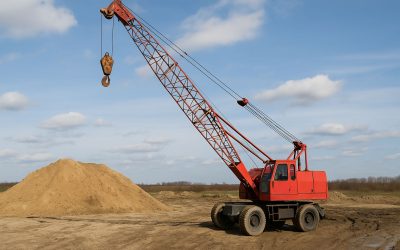When it comes to crane operations, lifting power isn’t just about muscle—it’s about mechanical efficiency. Two essential factors that influence performance are line pull and parts of line. By understanding how they work together, you can improve safety, extend equipment life, and increase operational efficiency.
What Is Line Pull in Cranes?
Line pull in cranes refers to the maximum force a single line of wire rope can exert to lift a load. Measured in pounds or tons, this force is defined by the hoist or winch system’s pulling power.
Why Line Pull Matters
- ✅ Prevents overloads – Ensures lifts remain within safe operating limits
- ✅ Maximizes efficiency – Directly impacts the crane’s lifting capacity
- ✅ Protects equipment – Reduces wear on winches, wire rope, and hoisting systems
You’ll find a crane’s rated line pull in the manufacturer’s specifications. Exceeding this limit increases the risk of mechanical failure and job site accidents.
What Are Parts of Line?
Parts of line describe how many times the crane’s wire rope is reeved (looped) through sheaves or pulleys to share the load. Increasing the number of parts of line distributes weight more evenly—greatly enhancing lifting strength, though it comes with a tradeoff in speed.
Common Configurations
- 🔹 Single-Part Line: One rope loop through the system
- 🔹 Multi-Part Line: Multiple reeved lines to reduce strain
Example:
- A single-part line carries 100% of the load weight.
- A four-part line divides the load across four rope sections, reducing stress on each and increasing total lift capacity.
More parts = more strength, but slower hoisting speeds. Operators must balance speed and power based on the task.
How Line Pull and Parts of Line Work Together
| Feature | Single-Part Line | Multi-Part Line |
|---|---|---|
| Lifting Capacity | Lower | Higher |
| Strain Per Section | High | Reduced |
| Hoisting Speed | Faster | Slower |
| Ideal For | Light, fast lifts | Heavy, controlled lifts |
When a load exceeds the crane’s single-line pull capacity, increasing the number of parts of line allows for safe lifting. But remember—more parts reduce speed, so plan accordingly.
Crane Safety Tips for Line Pull
To get the most from your equipment while staying safe:
- ✅ Always verify the rated line pull before lifting
- ✅ Use additional parts of line for heavier loads
- ✅ Follow manufacturer guidelines for proper reeving techniques
- ✅ Never exceed rated capacities
Understanding line pull in cranes and how to adjust the parts of line is key to safe, efficient operations.
Optimize Your Crane’s Performance with Crane Safe LLC
Need help calculating safe loads, choosing the right reeving setup, or understanding your crane’s lifting limits? Our certified experts at Crane Safe LLC are here to help.
Call Crane Safe LLC today at (360) 936-3704 or contact us for expert crane consulting, inspections, and safety training.



